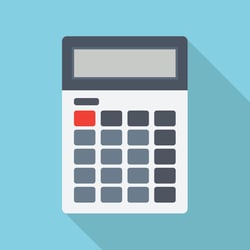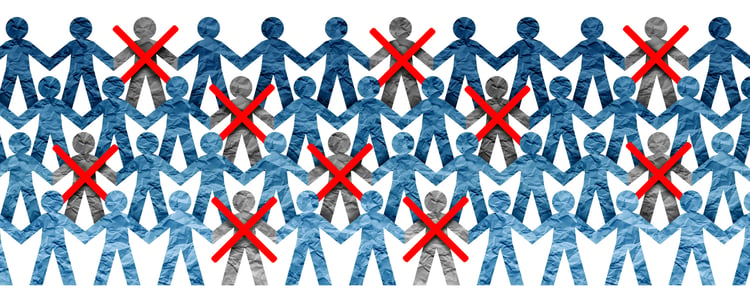One of the most important goals for B2B SaaS companies is customer retention. There are many ways to be successful at retaining customers and different metrics to evaluate a B2B SaaS company’s customer retention. In this blog, we will focus on those metrics, how to set benchmarks and sales strategies for expanding your customer base.
Table of Contents
Main Takeaways:
People often use customer retention and churn rate interchangeably. These are both important concepts when tracking the ability of a B2B company to retain customers however, they are distinct concepts.
Customer retention rate is the percentage of customers a company is able to retain after a certain period of time. For example, if you had 100 customers in 2022 and you enter 2023 with 96 of those customers still signed on for 2023, that company’s customer retention rate is 96%.
While the customer retention rate is how many customers a company retains, the churn rate is the percentage of customers that a company loses. In the former example, 4 of the 100 customers did not renew their contract for 2023 therefore, the churn rate for that company is 4%.
These concepts are two sides of the same coin but it’s important to understand the difference between them.
 Customer retention is not only important in B2B SaaS, one could argue that it’s the entire point of B2B SaaS businesses. Less than a couple of decades ago, the common B2B software model was to sell a one-time license to a company that they could use forever.
Customer retention is not only important in B2B SaaS, one could argue that it’s the entire point of B2B SaaS businesses. Less than a couple of decades ago, the common B2B software model was to sell a one-time license to a company that they could use forever.
Software companies realized that if they sell software on a subscription model rather than a one-time licensing model, they can generate recurring revenue and be more profitable. This sort of business model became possible due to the powerful cloud computing that has been popularized over the last 20 years.
It is due to this change in business model that SaaS companies emerged. Even legacy companies like Adobe moved to a SaaS model. Prior to this shift in the software sale business model, customer retention was not the biggest priority. A customer would have already paid the one-time licensing fee and the focus was mostly on expanding a software company’s footprint across the wider market.
The SaaS business model forces companies to convince their buyers to stay with them every year. The subscription has to be renewed for companies to realize recurring revenue. For many companies, a customer has to stay with them for a year or more for them to be able to break even.
Given the history of the B2B SaaS industry, customer retention goes beyond being just important; it is the entire driving force behind the business model.
The customer retention rate is the percentage of customers a company retains over a given period of time. Some companies may look at this month-month. For most B2B SaaS companies, the annual retention rate is usually a better metric since these tend to be annual or multi-year contracts. If you’re a B2B SaaS company selling monthly subscriptions however, then you might want to examine the monthly customer retention rate.
The basic formula is as follows:
This formula will give you the customer retention rate in percentage form. If you’ve lost customers, you will get a result that is under 100. A good benchmark for customer retention rate is above 95% and ideally over 97%.
But what happens if you add customers in that period?
This is the Net Customer Retention formula. It’s the same as the one above but instead of just accounting for the customers that left, it also adds in any new customers that have been signed by the sales team. Let's call this number Y1. The formula now looks like this:
Net Customer Retention Rate: 100-(N1-(N2+Y1)/N1)*100
If your company was able to add more customers than it lost, then your Net Customer Retention rate will be a above 100. Using the example mentioned before, let’s say a company added 7 new customers while losing 4 old ones. So they went from 100 to 96 customers but added 7 new customers. This would look like:
(100 - (100-(96+7))/100)*100 = 103
With the net customer retention rate coming in at 103, we can tell that overall the customer base grew by 3% despite losing some customers.
This result indicates that the net customer retention rate actually grew by 3%.
The customer retention metric gives us valuable insights but it is also helpful to look at the revenue retention rate. What if the 4 customers that the company lost were the biggest contracts that they had? The customer retention rate could obscure that view. Therefore, it is also important to look at revenue retention. To do this, simply subtract one period’s revenue by the revenue figure from a subsequent period.
($100,000 - $85,000) = $15,000
That result is the revenue lost number. Revenue in that period went down by $15,000. To find the revenue retention rate, divide the latest period’s revenue number by the revenue figure for the initial period. For example:
$85,000/$100,000 = 85%
In this example, the customer retention rate was 96% but the revenue retention rate was far lower at 85%. If a company stops at just the customer retention rate, they might think they are doing fine. The revenue retention rate lets a leader take a closer look at the overall health of the customer retention function of a B2B SaaS company.
The benchmark for the revenue retention rate is 97% or higher.
 The churn rate is the other side of the customer retention rate. The churn rate allows B2B SaaS companies see how many customers they are losing each year. By using the same definition for terms as above, a churn rate could be calculated using the following formula:
The churn rate is the other side of the customer retention rate. The churn rate allows B2B SaaS companies see how many customers they are losing each year. By using the same definition for terms as above, a churn rate could be calculated using the following formula:
Churn Rate = (N1-N2)/N1)*100
A good churn rate is below 5%. Ideally, the churn rate is 3% or lower.
This same formula can be used to measure the revenue churn rate, just replace the number of customers with the amount of revenue.
Just like how it was important to look at the net customer retention rate, it is also helpful to look at the net churn rate.
Net Churn Rate = ((N1-(N2+Y1))/N1)*100
In this scenario, a negative number is positive news. For example, let's say a customer started the period with 90 customers, they lost 4 of those customers but added 10 new customers. The calculation would look like:
Net Customer Churn Rate: ((90-(86+10)/90)*100 = -6.6
In this case, the net churn rate was negative. This means the overall customer base actually grew by 6.6%.
It’s one thing to track how well a B2B company’s customer retention is functioning. What about when you realize that your team needs to improve in this area?
There are many steps you can take related to onboarding and product support to retain customers. Here, we will focus on the sales strategies that will help a B2B SaaS company improve customer retention and reduce churn rate.
 In B2B sales, companies sell to other companies but it’s still another people at the client company that are making decisions. The product quality is important to retain customers but relationships that a seller or account manager has at a company is also just as important.
In B2B sales, companies sell to other companies but it’s still another people at the client company that are making decisions. The product quality is important to retain customers but relationships that a seller or account manager has at a company is also just as important.
When a B2B SaaS company loses customers, there is a good chance that the customer is gone because the person who initially brought the solution into the company has left the organization. During a customer lifecycle, decision-makers related to a solution can change. Therefore, it is important to continuously expand relationships within a client organization.
Having multiple people that are willing to champion your company’s solution will provide a floor of support for your solution at a client’s organization.
If you sell to enterprise accounts, don’t stop at just the relationships you can build within a specific department or business unit. Chances are, your solution can be useful for other stakeholders in the organization.
When it comes time for contract renewal, you want to make it hard for a company to cut ties with your solution. If a B2B SaaS solution is only present in a small facet within a small business unit, it might be an easy decision to cut that vendor from the budget. If however, a seller is able to cross-sell the solution to different departments, the company will be more reliant on that solution.
If you want to equip your team with the right skills to expand relationships and cross-sell across departments, be sure to take a look at our account management training course.
Ever heard of the saying that the best defense is a good offense? Well, that applies to customer retention as well. It is inevitable that there will be a certain amount of churn. Even well-functioning customer success departments might lose 2-3% of their customer base each year. In order to counter this loss, SaaS companies have to constantly be focused on adding new logos.
Adding new logos is definitely more expensive and time-consuming than retaining customers. You can tell from the examples above though that adding new customers can have a dramatic impact on the net customer retention and net churn rate. It can be the difference between an average performing B2B SaaS company and a hyper-growth company.
You can learn more about how to train your team to be successful by learning more about our B2B SaaS sales training program.

Abin Dahal is a practitioner dedicated to elevating his craft as well as helping others refine their skills. His impressive track record includes making hundreds of cold calls per week and scheduling over 500 meetings with VP and C-level prospects. He is a prospector, nurturer, and Inside Salesperson who brings integrity and spirit to our profession. At Funnel Clarity, he’s in the unique position of using and demonstrating the methodology in his sales efforts, leading his prospects and clients to say “I want my team to sell like that!”